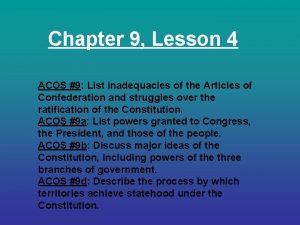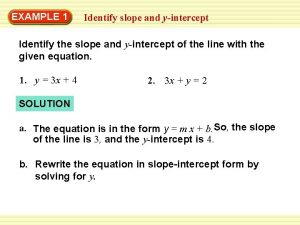5 1 Goals Identify the inadequacies in the














































- Slides: 46

5. 1 Goals • Identify the inadequacies in the Rutherford atomic model • Identify the new proposal in the Bohr model of the atom • Describe the energies and positions of electrons according to the quantum mechanical model • Describe how the shapes of orbitals related to different sublevels differ.

Development of Atomic Models Rutherford’s atomic model could not explain the chemical properties of elements. Bohr proposed that an electron is found only in specific circular paths (orbits) around the nucleus quanta (sing. - quantum): minimum quantity of energy that can be lost or gained by an atom

Quantum Mechanical Model Schrödinger created equations giving the specific energies to describe an e- motion quantum mechanical model determines the allowed energies an e- can have and how likely it is to find the e- in various locations around the nucleus. comparison of Bohr and Quantum models

Atomic Orbitals a region of space in which there is a high probability of finding an electron an orbital can hold only 2 e-

Quantum Numbers • Schrödinger’s equations specify the properties of atomic orbitals and the properties of e in that orbital (address of a specific e ) • there are 4 quantum numbers

Energy Level Principle Quantum Number (n) main energy level as n becomes larger, the atom becomes larger and the electron is further from the nucleus principle quantum number = number of sublevels within that principle energy level

Sublevels Angular Momentum Quantum Number (l) shape of orbital (sublevel within energy level) usually use letters for l s, p, d and f

Sublevels each energy sublevel corresponds to an orbital of a different shape, which describes where the electron is likely to be found s spherical p dumbbell d, f, g, etc. very complex

Other Quantum Numbers Magnetic Quantum Number (m) gives the 3 D orientation of each orbital along the x, y, or z axis





Other Quantum Numbers Spin Quantum Number (s) spin of electron is clockwise (CW) or counterclockwise (CCW)

5. 1 Section Quiz. Rutherford's planetary model of the atom could not explain a) any properties of elements. b) the chemical properties of elements. c) the distribution of mass in an atom. d) the distribution of positive and negative charges in an atom. – 1.

5. 1 Section Quiz. Bohr's model of the atom proposed that electrons are found a) embedded in a sphere of positive charge. b) in fixed positions surrounding the nucleus. c) in circular orbits at fixed distances from the nucleus. d) orbiting the nucleus in a single fixed circular path. – 2.

5. 1 Section Quiz. What is the lowest-numbered principal energy level in which p orbitals are found? a) 1 b) 2 c) 3 d) 4 – 3.

5. 2 Goals • Describe how to write the electron configuration for an atom. • Explain why the actual electron configurations for some elements differ from those predicted by the Aufbau Principle.

5. 2 Electron Arrangement in Atoms change proceeds towards the lowest possible energy – in an atom the most stable arrangement is achieved by the electrons arranging themselves around the nucleus in specific electron configurations

Aufbau, Pauli, and Hund • Aufbau Principle: electrons occupy the orbitals of lowest energy first • Pauli Exclusion Principle: no 2 e in the same atom have the same set of all 4 quantum numbers • Hund’s Rule: orbitals of equal energy are each occupied by one e before any orbital is occupied by a second e and all electrons in singly occupied orbitals must have the same spin


Orbital Diagrams • movie

Diagonal Rule

Configuration Shorthand write the energy level and the symbol for every sublevel occupied by an electron indicate the number of electrons occupying that sublevel with a superscript


Exceptions to Electron Configurations • filled sublevels are very stable • the next most stable configuration is one electron in each orbital (half filled sublevel) • examples: Cr and Cu

5. 2 Section Quiz. – 1. Identify the element that corresponds to the following electron configuration: 1 s 22 p 5. A) F B) Cl C) Ne D) O

5. 2 Section Quiz. – 2. Write the electron configuration for the atom N. A) 1 s 22 p 5 B) 1 s 22 p 3 C) 1 s 22 s 1 p 2 D) 1 s 22 p 1

5. 2 Section Quiz. – 3. The electron configurations for some elements differ from those predicted by the aufbau principle because the • the lowest energy level is completely filled. • none of the energy levels are completely filled. • half-filled sublevels are less stable than filled energy levels. • half-filled sublevels are more stable than some ` other arrangements.

5. 3 Goals Describe the relationship between the wavelength and frequency of light. Identify the source for atomic emission spectra Explain how the frequencies of emitted light are related to changes in electron energies Distinguish between quantum mechanics and classical mechanics

Physics and the Quantum Mechanical Model • wavelength (λ): distance between peaks of a wave measured in cm, nm (1 109 nm = 1 m), or Å (1 1010 Å = 1 m) • frequency (ν): number of peaks that pass a given point in a specific amount of time (usually one second) 1 wave/second = hertz (Hz)


Electromagnetic Spectrum • Electromagnetic radiation makes up the electromagnetic spectrum. • travels by waves light, radio, UV, IR, X-ray • constant speed c = 2. 998 108 m/s


Electromagnetic Radiation • All electromagnetic waves travel at the same speed - the speed of light which is a constant (in a vacuum) c = λν wavelength is inversely proportional to frequency



Bohr Model of the Atom • ground state: lowest energy state of an atom • excited state: atom with a higher energy than its ground state • excited state ground state energy is released as electromagnetic radiation (colored light) • Since elements give off specific line-emission spectra, e exist only in specific energy states


The Photoelectric Effect • The photoelectric effect provides evidence for the particle nature of light. • movie

Atomic Spectra • Max Planck related quanta of energy to the frequency of the electromagnetic radiation E=hν • h = Planck’s constant 6. 626 10 34 Js

Louis de Broglie • consider e to behave like waves must be confined to a space with a specific frequency around the nucleus • works very well for particles of very small mass (quantum mechanics)

Werner Heisenberg • looking at e requires doing something to the atom like shining a light on it and this would add energy that changes where the e is • Heisenberg Uncertainty Principle: it is impossible to determine both position and velocity of an e

5. 3 Section Quiz. – 1. Calculate the frequency of a radar wave with a wavelength of 125 mm. A) 2. 40 109 Hz B) 2. 40 1024 Hz C) 2. 40 106 Hz D) 2. 40 102 Hz

5. 3 Section Quiz. – 2. The lines in the emission spectrum for an element are caused by A) the movement of electrons from lower to higher energy levels. B) the movement of electrons from higher to lower energy levels. C) the electron configuration in the ground state. D) the electron configuration of an atom.

5. 3 Section Quiz. – 3. Spectral lines in a series become closer together as n increases because the A) energy levels have similar values. B) energy levels become farther apart. C) atom is approaching ground state. D) electrons are being emitted at a slower rate.
 Linguistics vs traditional grammar
Linguistics vs traditional grammar Strategic goals tactical goals operational goals
Strategic goals tactical goals operational goals Strategic goals tactical goals operational goals
Strategic goals tactical goals operational goals General goals and specific goals
General goals and specific goals Motivation in consumer behaviour
Motivation in consumer behaviour Sơ đồ cơ thể người
Sơ đồ cơ thể người Các số nguyên tố
Các số nguyên tố Tia chieu sa te
Tia chieu sa te đặc điểm cơ thể của người tối cổ
đặc điểm cơ thể của người tối cổ Các châu lục và đại dương trên thế giới
Các châu lục và đại dương trên thế giới Thang điểm glasgow
Thang điểm glasgow ưu thế lai là gì
ưu thế lai là gì Tư thế ngồi viết
Tư thế ngồi viết Cái miệng nó xinh thế chỉ nói điều hay thôi
Cái miệng nó xinh thế chỉ nói điều hay thôi Mật thư tọa độ 5x5
Mật thư tọa độ 5x5 Các châu lục và đại dương trên thế giới
Các châu lục và đại dương trên thế giới Bổ thể
Bổ thể Tư thế ngồi viết
Tư thế ngồi viết Thẻ vin
Thẻ vin Ví dụ về giọng cùng tên
Ví dụ về giọng cùng tên Thơ thất ngôn tứ tuyệt đường luật
Thơ thất ngôn tứ tuyệt đường luật Chúa yêu trần thế
Chúa yêu trần thế Từ ngữ thể hiện lòng nhân hậu
Từ ngữ thể hiện lòng nhân hậu Khi nào hổ con có thể sống độc lập
Khi nào hổ con có thể sống độc lập Diễn thế sinh thái là
Diễn thế sinh thái là Vẽ hình chiếu vuông góc của vật thể sau
Vẽ hình chiếu vuông góc của vật thể sau 101012 bằng
101012 bằng Tỉ lệ cơ thể trẻ em
Tỉ lệ cơ thể trẻ em Lời thề hippocrates
Lời thề hippocrates đại từ thay thế
đại từ thay thế Vẽ hình chiếu đứng bằng cạnh của vật thể
Vẽ hình chiếu đứng bằng cạnh của vật thể Quá trình desamine hóa có thể tạo ra
Quá trình desamine hóa có thể tạo ra Môn thể thao bắt đầu bằng từ chạy
Môn thể thao bắt đầu bằng từ chạy Công thức tính độ biến thiên đông lượng
Công thức tính độ biến thiên đông lượng Thế nào là mạng điện lắp đặt kiểu nổi
Thế nào là mạng điện lắp đặt kiểu nổi Hình ảnh bộ gõ cơ thể búng tay
Hình ảnh bộ gõ cơ thể búng tay Khi nào hổ con có thể sống độc lập
Khi nào hổ con có thể sống độc lập Các loại đột biến cấu trúc nhiễm sắc thể
Các loại đột biến cấu trúc nhiễm sắc thể Nguyên nhân của sự mỏi cơ sinh 8
Nguyên nhân của sự mỏi cơ sinh 8 độ dài liên kết
độ dài liên kết Chó sói
Chó sói Thiếu nhi thế giới liên hoan
Thiếu nhi thế giới liên hoan điện thế nghỉ
điện thế nghỉ Một số thể thơ truyền thống
Một số thể thơ truyền thống Trời xanh đây là của chúng ta thể thơ
Trời xanh đây là của chúng ta thể thơ Thế nào là hệ số cao nhất
Thế nào là hệ số cao nhất





































































